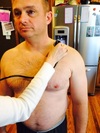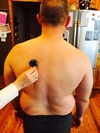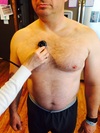Thorax and Lungs Evaluation Flashcards
(49 cards)
Left Upper Lobe Apicoposterior Segment
Above the clavicle along the midclavicular line

Left Upper Lobe Anterior Segment
Somewhere between the 1st and 2nd intercostal space medially

Left Upper Lobe Superior Lingula Segment
In the 3rd intercostal space between the midclavicular and axillary lines

Left Upper Lobe Inferior Lingula Segment
Somewhere between the 4th intercostal space and the 5th rib near the apex of the heart

Left Lower Lobe Anteromedial Basal Segment
Somewhere between the 5th intercostal space and the 6th rib along the midclavicular line

Left Lower Lobe Superior Segment
Somewhere between 1” below the spine of the scapula and 1” above the inferior angle medially

Left Lower Lobe Lateral Basal Segment
Somewhere between 1” above/below the inferior angle of the scapula and the 10th intercostal space laterally

Left Lower Lobe Posterior Basal Segment
Somewhere between 1” above the inferior angle of the scapula and the 10th intercostal space medially

Right Upper Lobe Apicoposterior Segment
Above the clavicle along the midclavicular line

Right Upper Lobe Anterior Segment
Somewhere between the 1st and 2nd intercostal spaces medially

Right Upper Lobe Posterior Segment
1” above the spine of the scapula medially

Right Middle Lobe Lateral Segment
Somewhere between the 3rd intercostal space and the 5th rib laterally

Right Middle Lobe Medial Segment
Somewhere between the 3rd and 5th intercostal spaces medially

Right Lower Lobe Superior Segment
Somewhere between 1” below the spine of the scapula and 1” above the inferior angle of the scapula medially

Right Lower Lobe Anterior Basal Segment
In the 5th intercostal space or 6th rib area between the midclavicular and axillary lines

Right Lower Lobe Lateral Basal Segment
Somewhere between 1” above/below the inferior angle of the scapula and the 10th intercostal space laterally

Right Lower Lobe Posterior Basal Segment
Somewhere between 1” above the inferior angle and the 10th rib medially

When inspecting rate, rhythm, and depth of breathing you would typically expect RR to be __-__ breaths per minute.
12-20
What are a few indications of respiratory distress?
- Increased RR
- Nasal flaring
- Intercostal and sternal retracftions
- Visible expression of distress
- Increased use of neck accessories
- Paradoxic breathing
What are 2 chest abnormalities to look for?
Pectus excavatum (funnel chest)
Pectus carinatrum (pigeon chested)
Assessment of the neck reveals jugular vein distention, what does this indicate?
cor pulmonae (R side heart failure)
What things should you look for in regards to chest dimensions?
- scoliosis
- barrel chest (hyperinflation)
- kyphosis
- professorial positioning
The normal AP dimension of the chest is how big?
How big is the transverse dimension?
1/2 the size of the transverse dimension, which is usually the width of the shoulder
Why is important to ask about couch production?
Weak and ineffective cough production is indicative ofweak respiratory musculature








